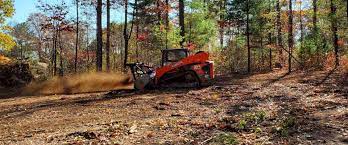Recreational trails provide outdoor enthusiasts with opportunities to explore, exercise, and establish a connection with nature as they wind through some of the most breathtaking natural landscapes. But not all trails are accessible, and it can be difficult to make a path through thick undergrowth and uneven ground. Forestry mulching is useful in this situation. This blog post will discuss how forestry mulching is transforming the construction of recreational trails and increasing their accessibility for all users.
Comprehending Forestry Mulching
Forestry mulching is a method of clearing land that involves removing underbrush and vegetation using specialized machinery called mulchers or masticators. In contrast to conventional land clearing techniques that utilize chainsaws or bulldozers, forestry mulching is a more effective and ecologically friendly method.
This is how it operates:
- Mulcher Attachment: An excavator or skid steer is equipped with a mulcher attachment.
- Processing of Vegetation: The mulcher shreds and mulches vegetation, including trees, shrubs, and dense undergrowth, using a revolving drum with sharp teeth.
- Even Distribution: By distributing the mulched material evenly across the ground, a layer of mulch that can aid in weed suppression and erosion control is created.
Advantages of Forestry Mulching for Trails Used for Recreation:
The following are a few noteworthy advantages of forestry mulching for the construction of recreational trails:
- Effective Clearing of Land:
Large tracts of dense vegetation can be rapidly cleared through the very effective method of forestry mulching. When creating recreational trails, this efficiency is essential because it reduces project costs and schedules.
- Minimal Emissions into the Environment:
In contrast to conventional land clearing techniques that may cause soil erosion and harm to root systems, forestry mulching essentially preserves the topsoil. By doing this, the trail’s environmental impact is lessened and the surrounding trees’ health is maintained.
- Enhanced Easily Accessible:
The increased accessibility that forestry mulching offers recreational trails is one of its main advantages. Mulching makes trails for cyclists, hikers, and outdoor enthusiasts of all skill levels clear and compassable by clearing trees, underbrush, and other impediments.
- Improvement of Safety:
Through the removal of potential hazards like fallen trees, dense vegetation, and hidden obstacles, forestry mulching greatly increases trail safety. This lowers the possibility of accidents and makes recreational trails safer for users.
- Conserving the Beauty of Nature:
Forestry mulching removes vegetation, but it also keeps the landscape’s organic beauty intact. The trail’s aesthetics can be improved by carefully preserving trees and other desirable vegetation.
- Management of Erosion:
Through stabilizing the soil, lowering runoff, and avoiding soil compaction, the mulch left over from forestry mulching contributes to the control of erosion. This is particularly crucial in regions with steep terrain.
- Subduing Weeds:
Weed growth is inhibited by the mulch layer formed by forestry mulching, which lessens the need for continuous trail maintenance and weed control initiatives.
- Little Interruptions:
Mulching forests is a low-impact method that causes the least amount of disturbance to the environment. It is appropriate for sensitive areas because it is less noisy and invasive than conventional land clearing techniques.
Forestry Mulching Considerations for Recreational Trails:
Although forestry mulching has many advantages, there are a few things to think about when applying this technique to the creation of trails:
- Environmental Assessment: To identify any sensitive or protected species and their habitats, carry out an environmental assessment prior to starting a forestry mulching project. To reduce impact, this information can help with the planning and implementation of the mulching process.
- Selective Retention: To improve the trail’s appearance and offer shade and natural beauty, decide which trees or other vegetation should be kept in place.
- Trail Design: Create a trail layout that optimizes accessibility, reduces environmental impact, and makes use of the natural terrain by collaborating with environmental experts and trail designers.
- Appropriate Equipment: Make sure the forestry mulching machinery being used for the project is suitable for the trail development’s size, terrain, and scope.
- Erosion Control: To reduce any possible problems with soil erosion that may occur during and after mulching, put in place erosion control measures like check dams and sediment barriers.
Professional forestry mulching and trail development services, like those offered by https://blueridgelandenhancements.com/ bring a wealth of knowledge, experience, and resources to the table. They can help you navigate the complexities of creating recreational trails through forestry mulching while ensuring environmental preservation, compliance with regulations, and the highest quality standards. When embarking on a trail development project, it’s a wise choice to partner with professionals who can bring your vision to life while safeguarding the environment.
In Summary:
Recreational trail construction has been transformed by forestry mulching, which improves accessibility, safety, and environmental friendliness. This technique for clearing land effectively removes thick undergrowth and impediments, improving trail accessibility for hikers of all skill levels. Forestry mulching can contribute to the creation of stunning, eco-friendly, and hospitable recreational trails that foster active, healthy lifestyles and connect communities with nature when done carefully and with environmental consideration, find more here.



